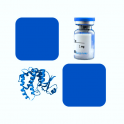
- Remove this product from my favorite's list.
- Add this product to my list of favorites.
Products
Viewed products
Newsletter
 |  |  |  |  |  |

Background
T-cell surface glycoprotein CD3 delta & CD3 epsilon chain, also known as CD3D & CD3E or CD3D&CD3E respectively, are single-pass type I membrane proteins. CD3D, together with CD3- epsilon(CD3E) , CD3-gamma and CD3-zeta, and the T-cell receptor alpha/beta and gamma/delta heterodimers, forms the T cell receptor-CD3 complex. T cell receptor-CD3 complex plays an important role in coupling antigen recognition to several intracellular signal-transduction pathways.
Source
MABSol® Recombinant Biotinylated Human CD3E&CD3D Heterodimer Protein, Fc,His Tag&Fc,Flag Tag, primary amine labeling (CDD-H82W0) is expressed from human HEK293 cells. It contains AA Asp 23 - Asp 126 (CD3E) & Phe 22 - Ala 105 (CD3D) (Accession # NP_000724.1(CD3E) & NP_000723.1(CD3D)). It is the biotinylated form of Human CD3E&CD3D Heterodimer Protein, Fc,His Tag&Fc,Flag Tag (CDD-H52W0).
Predicted N-terminus: Asp 23 (CD3E) & Phe 22 (CD3D)
Molecular Characterization
The subunit CD3E carries a human IgG1 Fc fragment at the C-terminus, followed by a polyhistidine tag. The subunit CD3D carries a human IgG1 Fc fragment at the C-terminus, followed by a flag tag. The protein has a calculated MW of 39.2 kDa (CD3E) and 37.5 kDa (CD3D) . The protein migrates as 45-55 kDa on a SDS-PAGE gel under reducing (R) condition due to glycosylation.
Biotinylation
The primary amines in the side chains of lysine residues and the N-terminus of the protein are conjugated with biotins using standard chemical labeling method. A standard biotin reagent (13.5 angstroms) is used in this product.
Protein Ratio
Passed as determined by the HABA assay / binding ELISA.
Endotoxin
Less than 1.0 EU per μg by the LAL method.
Purity
>95% as determined by SDS-PAGE.
>90% as determined by SEC-MALS.
Formulation
Lyophilized from 0.22 μm filtered solution in PBS, pH7.4 with trehalose as protectant.
Reconstitution
Please see Certificate of Analysis for specific instructions.
For best performance, we strongly recommend you to follow the reconstitution protocol provided in the CoA.
Storage
For long term storage, the product should be stored at lyophilized state at -20°C or lower.
Please avoid repeated freeze-thaw cycles.
This product is stable after storage at:
-20°C to -70°C for 12 months in lyophilized state;
-70°C for 3 months under sterile conditions after reconstitution.
Bioactivity
Please refer to product data sheet.
(1) "Identification of Genes Associated with Decreasing Abundance of Monocytes in Long-Term Peritoneal Dialysis Patients"
Zhang, Jin, Wang et al
Int J Gen Med (2023) 16, 5017-5030
(2) "Correlation Analysis of Prognostic Gene Expression, Tumor Microenvironment, and Tumor-Infiltrating Immune Cells in Ovarian Cancer"
Li, Yang, Ling et al
Dis Markers (2023) 2023, 9672158
(3) "Leveraging Genomic and Bioinformatic Analysis to Enhance Drug Repositioning for Dermatomyositis"
Irham, Adikusuma, La'ah et al
Bioengineering (Basel) (2023) 10 (8)
Showing 1-3 of 49 papers.
Follow us